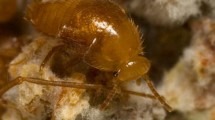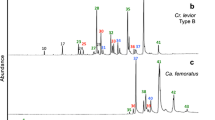Summary.
Neotropical “Fungus-growing” leaf-cutting ants (tribe Attini) live in obligatory symbiosis with a fungus, which they grow on fresh leaves harvested by workers. Colonial recognition is likely based on chemical cues provided by cuticular hydrocarbons that have been found to be partly influenced by environmental odor sources. The diet breadth of Acromyrmex subterraneus subterraneus enabled us to test the impact of different plant diets on colonial recognition. The intermediary of the fungus in the ants’ feeding habit adds a special angle to the question. From a queenright (QR) mother colony of A. s. subterraneus we formed several groups of queenless (QL) workers with fungus (approx. 700 ants). The QR colony and two of the QL-groups were fed with the same diet of fresh bramble leaves. Two other QL-groups were fed with privet leaves and two with rose flowers. After 4 months, QR workers were significantly more aggressive towards the QL-group fed with rose flowers or privet leaves than towards workers of the QL-groups fed with fresh bramble leaves. Rose-fed QL workers were aggressive towards privet-fed QL workers and vice versa, but never towards workers of their counterpart group that fed on the same diet. These results suggest that the absence of the queen or the separation time between groups played a minor role in shaping nestmate recognition cues as compared to the diet. The behavioral studies were supplemented by chemical analyses of cuticles, postpharyngeal glands (PPG) and plant-food extracts revealing profiles variations that were correlated with the dietary changes. However, although the plant extract contained several hydrocarbons there was no congruency between the plant profile and the respective diet-group ants. These results support the hypothesis that the diet influences indirectly the chemical profiles and consequently the recognition cues in A. s. subterraneus.
Similar content being viewed by others
Author information
Authors and Affiliations
Corresponding author
Rights and permissions
About this article
Cite this article
Richard, FJ., Hefetz, A., Christides, JP. et al. Food influence on colonial recognition and chemical signature between nestmates in the fungus-growing ant Acromyrmex subterraneus subterraneus . Chemoecology 14, 9–16 (2004). https://doi.org/10.1007/s00049-003-0251-3
Received:
Accepted:
Issue Date:
DOI: https://doi.org/10.1007/s00049-003-0251-3




